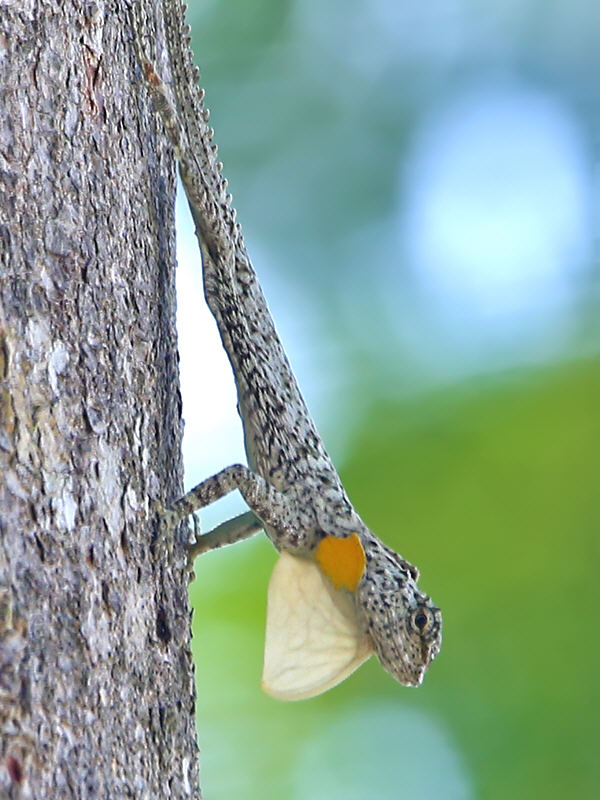 |
Family : AGAMIDAE
Species : Draco punctatus
Size (snout to vent) : male 9.7 cm, female 8.8 cm
Size (total length) : male ~26 cm, female ~24 cm
Draco punctatus
(Fringed Gliding Lizard), formerly known as Draco fimbriatus, is an
uncommonly sighted lizard; there appear to be very few records in comparison
to other species which occur in the same habitat i.e. hilly areas with
dipterocarp forest.
(The former name of Draco fimbriatus [Orange-bearded
Gliding Lizard] now applies to a closely-related species which has a
broad, orange gular flag (McGuire et al, 2018).
In the field, male Draco punctatus can be identified by their white
triangular gular flag, tipped with yellow, and the skin beneath the
lappets which is also yellow (see Fig. 1). The female example shown here (Fig. 2)
has a small patch of yellow on the gular flag, which is lying flat beneath
the chin; this suggests some similarity between
the gular flags of males and females.
The dorsal colour of Draco punctatus varies widely, ranging from pale
grey to brownish to greenish, with complex patterning giving it a mottled
appearance. There is a dark spot on the front of the head which also helps
with identification.
The patagium is usually dark brown, patterned with thin, pale lines. Its
tail is long and thin, and measures around 1.7 times head-body length.
Males can be confidently distinguished from females by the presence of a row of
lanceoloate (i.e. enlarged, rounded) scales along the top of the tail.
Draco punctatus is known to occur in southern Thailand, parts of
northern and central Peninsular Malaysia, Sumatra and Java. There appear to
be no formally published records from southern parts of Peninsular Malaysia and
Singapore.
It is unclear whether Draco punctatus occurs on the island of Borneo,
given McGuire et al's taxonomic changes in 2018.
Fig 1 : Example from Bintan Island, Riau Archipelago, Indonesia. The
lanceoloate (i.e. elongated and rounded) scales along the tail identify
this lizard as a male. The exposed lappets are a strong yellow colour, but
the yellow marking at the tip of the gular flag is barely apparent in this
example. Photo thanks to Noel Thomas.
Fig 2 : Another male example from Kledang Saiong, near Ipoh, Perak,
Peninsular Malaysia, warming itself in direct sunlight with patagium and
gular flag extended.
References :
Grismer, L. L. (2011). Lizards of Peninsular Malaysia, Singapore, and their
Adjacent Archipelagos. Their Description, Distribution, and Natural History.
Edition Chimaira, Frankfurt am Main. 728 pp.
Grismer, L. L., & Quah, E. S. (2019). An updated and annotated checklist of
the lizards of Peninsular Malaysia, Singapore, and their adjacent
archipelagos. Zootaxa, 4545(2), 230-248
McGuire, Jimmy A., Darko D. Cotoras, Brendan O’Connell, Shobi ZS Lawalata,
Cynthia Y. Wang-Claypool, Alexander Stubbs, Xiaoting Huang et al. (2018) "Squeezing
water from a stone: high-throughput sequencing from a 145-year old holotype
resolves (barely) a cryptic species problem in flying lizards." PeerJ 6
(2018): e4470
|